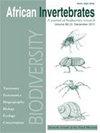The temporal occurrence of flesh flies (Diptera, Sarcophagidae) at carrion-baited traps in Grahamstown, South Africa
IF 1.1
4区 农林科学
Q3 ENTOMOLOGY
引用次数: 10
Abstract
Eleven species of flesh fly were identified in a sample of 737 specimens captured during fortnightly trapping at three sites in Grahamstown, South Africa, over a year. Sarcophaga africa Wiedemann, 1824, S. inaequalis Austen, 1909, S. exuberans Pandellé, 1896 and S. tibialis Macquart, 1851 showed well-defined peaks between early October 2001 and late April 2002, and only S. africa was trapped at other times of year. These peaks occurred when average minimum and maximum ambient air temperatures were above 12°C and 22°C, respectively, and showed no obvious relationship to rainfall. There were indications of population cycles in all of these species. Sarcophaga hera Zumpt, 1972, S. arno Curran, 1934, S. inzi Curran, 1934, S. langi Curran, 1934, S. freyi Zumpt, 1953, S. nodosa Engel, 1925 and S. samia Curran, 1934 were too scarce to assess their patterns of occurrence rigorously. Insects attending a corpse are reputed to assist forensic entomologists in estimating the time of year when the body died. Some flesh flies provide more precise estimates than others, so several species should be used for cross-validation. Insect activity at a corpse depends on the weather, so that presence of a species indicates particular environmental conditions and not simply calendar dates (particularly if climate changes). Absence of a species is not necessarily evidence of specific conditions because species may not be present at all sites simultaneously, populations cycle even when their members are active, and low population densities may hamper detection of a species. African Invertebrates 58(1): 1–8 (2017) doi: 10.3897/AfrInvertebr.58.9537 http://africaninvertebrates.pensoft.net Copyright Martin H. Villet et al. This is an open access article distributed under the terms of the Creative Commons Attribution License (CC BY 4.0), which permits unrestricted use, distribution, and reproduction in any medium, provided the original author and source are credited. RESEARCH ARTICLE Martin H. Villet et al. / African Invertebrates 58(1): 1–8 (2017) 2南非Grahamstown地区腐肉诱捕器中肉蝇(双翅目,麻蝇科)的时间分布
在一年多的时间里,在南非Grahamstown的三个地点每两周捕获一次的737个标本中,发现了11种肉蝇。Sarcophaga africa Wiedemann,1824年,S.inaequip Austen,1909年,S.experians Pandellé,1896年和S.tibialis Macquart,1851年,在2001年10月初至2002年4月底期间出现了明确的峰值,只有南非在一年中的其他时间被困。这些峰值出现在平均最低和最高环境气温分别高于12°C和22°C时,与降雨量没有明显关系。所有这些物种都有种群周期的迹象。Sarcophaga hera Zumpt,1972年,S.arno Curran,1934年,S.inzi Curran,1935年,S.langi Curran,1953年,S.freyi Zumpt、S.nodosa Engel,1925年和S.samia Curran(1934年)太少,无法严格评估其发生模式。昆虫处理尸体被认为有助于法医昆虫学家估计尸体一年中的死亡时间。一些肉蝇提供了比其他更精确的估计,因此应该使用几个物种进行交叉验证。昆虫对尸体的活动取决于天气,因此一个物种的存在表明了特定的环境条件,而不仅仅是日历日期(尤其是在气候变化的情况下)。物种的缺乏不一定是特定条件的证据,因为物种可能不会同时出现在所有地点,即使其成员活跃,种群也会循环,并且低种群密度可能会阻碍对物种的检测。非洲无脊椎动物58(1):1-8(2017)doi:10.3897/AfrInvertebr.58.9537http://africaninvertebrates.pensoft.net版权所有Martin H.Villet等人。这是一篇根据知识共享署名许可证(CC BY 4.0)条款分发的开放获取文章,该许可证允许在任何媒体上不受限制地使用、分发和复制,前提是原始作者和来源可信。研究文章Martin H.Villet等人/非洲无脊椎动物58(1):1-8(2017)2
本文章由计算机程序翻译,如有差异,请以英文原文为准。
求助全文
约1分钟内获得全文
求助全文
来源期刊

African Invertebrates
生物-动物学
CiteScore
1.00
自引率
0.00%
发文量
6
审稿时长
>12 weeks
期刊介绍:
African Invertebrates is an international peer-reviewed, open-access journal that focuses primarily on the taxonomy, systematics, biogeography, and palaeontology of Afrotropical invertebrates, whether terrestrial, freshwater or marine. Aspects concerning biology, ecology, and conservation may also be considered where these relate to the primary focus areas. Papers dealing solely with biology, ecology, physiology, pests and pest control should be submitted elsewhere.
 求助内容:
求助内容: 应助结果提醒方式:
应助结果提醒方式:


